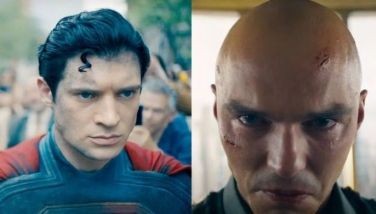A deliriously silly caper
July 17, 2004 | 12:00am
 The latest remake of Jules Verne’s 1873 globe-trotting fantasy, Around the World in 80 Days, is a deliriously silly caper that goes out of its way to thumb its nose at logic. This swatch of epic slapstick, in which three madcap adventurers headed by Passepartout (Jackie Chan) from London play beat the clock in a race to circle the earth by any means, let all its seams show. Don’t ask how the travelers get out of one scrape and proceed to the next. Let the computer-generatedanimated chapter introductions fill in the blanks.
The latest remake of Jules Verne’s 1873 globe-trotting fantasy, Around the World in 80 Days, is a deliriously silly caper that goes out of its way to thumb its nose at logic. This swatch of epic slapstick, in which three madcap adventurers headed by Passepartout (Jackie Chan) from London play beat the clock in a race to circle the earth by any means, let all its seams show. Don’t ask how the travelers get out of one scrape and proceed to the next. Let the computer-generatedanimated chapter introductions fill in the blanks.
What distinguishes this rendition from the nearly three-hour 1956 version, which won the Oscar for best picture, is the presence of that coiled human whirlwind, Jackie Chan as Passepartout.
Jackie makes his entrance diving out a window of the Bank of England in a Keystone Kops-like chase. The whiz-bang set pieces, where Jackie fends off assailants in exotic locales, are the movie’s dizzying high points.
Jackie’s movies have always included a high quotient of physical comedy. Here, he sheds the last superficial trappings of action-adventure heroism to become a poker-faced clown and Harold Lloyd-like escape artist repeatedly roughed up but remaining unruffled. He is considerably more vulnerable than usual and far from self-sufficient. A fight in the back of an art gallery leaves him a walking, messed-up paint sample. During a melee in China, a team of fellow warriors materializes in time to help drive away his enemies. Near the end of the movie Fogg risks hislife to drag Passepartout out of the way of a collapsing wall.
The movie, directed by Frank Coraci (The Waterboy, The Wedding Singer), has drastically retooled the story to fit Jackie’s Asian roots. While diving out of the Bank of England, Passepartout clutches a precious green jade Buddha he hopes to return to the village in China from which it was taken. Desperate to find the fastest route back, he latches on to Fogg, who has made a high-stakes bet with Lord Kelvin (Jim Broadbent), the bewhiskered head of Britain’s Royal Academy of Science, that he can circle the globe in record time. For the first of many endurance tests, Passepartout volunteers to be the guinea pig in Fogg’s experiment at pushing the 50-mile-per-hour human speed barrier in a zany homemade car propelled along a track that collapses and sends Passepartout flying.
Where the 1956 Around the World featured the mustached clown Cantinflas the "Mexican Charlie Chaplin" as Passepartout, and bullfighting became the sport of choice, this version focuses on martial arts farce.
The witty Rube Goldberg-worthy contraptions remind us that until today’s high-tech environment, machines used to be funny. It’s refreshing and perhaps even useful to see a movie that shows how susceptible to breakdown they really are. The most wonderfully far-fetched gadget is the airplane Fogg improvises from plans handed him by the Wright Brothers (Luke and Owen Wilson) and builds out of a dismantled ship. The device, which swoops uncertainly through the sky, suggests a bicycle borne aloft on giant butterfly wings.
The 1956 Around the World in 80 Days more or less invented the idea of the all star cast , in which stars (like Frank Sinatra, Marlene Dietrich, Red Skelton and about two dozen others) popped up in different countries sometimes, in disguise. The new version modestly advances the tradition. The funniest surprise giant star is Arnold Schwarzenegger, starring as a bejeweled narcissistic Turkish prince, who kidnaps the travelers and wants to marry one of the travelers (Cécile de France). Kathy Bates appears as a smirking Queen Victoria and Rob Schneider as a superstitious San Francisco beggar, who taught the travelers how to beg when they were out of luck.
The movie stars Hong Kong martial arts expert Samo Hung, singer Macy Gray and other well-known personalities.
Despite its contemporary touches, Around the World in 80 Days is a satisfying slice of old-fashioned storybook entertainment. It proudly insists on its own innocence.
In describing the film’s objectives, director Frank Coraci says, "Our overall goal was to make an epic with a sense of humor; a fun movie that brings audiences to new places."
Jackie, who shows his signature comic-action style in several well-choreographed encounters,welcomed the opportunity to work with Coraci.
"Frank was very open to all the ideas I had for the action scenes," Jackie explains.
Who wouldn’t be open to Chan’s ideas for action scenes? His blend of comedy and martial arts has given some of filmdom’s most exciting, dynamic action sequences.
Another spectacular fight scene is in the film’s middle. Not only do you get to see Jackie Chan fight in the middle of an open field for the first time since the old Drunken Master days, but it’s a multi-fight incorporating lots of Chan’s breathtaking stunts in full choreography with no camera tricks.
The action is a compendium of classic Jackie Chan moments. There’s handcuff jokes from Project A 2, rope work from Miracles, hanging work from Supercop and bench stuff from the old Drunken Master/Snake in the Eagle Shadow days. Sometimes he does new gags with the devices, usually it’s a repeat, but it still works. Propping up the prisoner stands seems reminiscent of the vases in Rush Hour but it’s always fun to see Jackie Chan do two things at once. He uses a ladder again, but actually in a different way from First Strike. All of this is incorporated into the flow of action very well.
BrandSpace Articles
<
>
- Latest
- Trending
Trending
Latest
Trending
Latest
Recommended
































